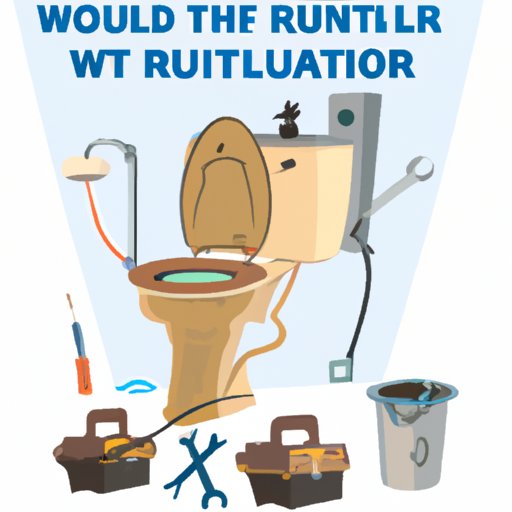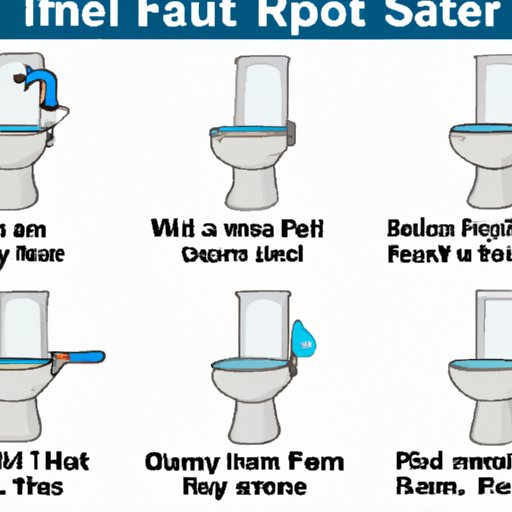
Introduction
A running toilet can be a frustrating and wasteful problem for homeowners. If your toilet runs continuously, it can waste a lot of water and increase your monthly bills. Fortunately, many running toilet issues can be fixed easily and inexpensively. In this article, we’ll provide you with a complete guide to diagnose and fix a running toilet.

5 Easy Steps to Fix a Running Toilet
If you’re dealing with a running toilet that won’t stop after flushing, there are five essential steps you should take to fix the problem.
Step 1: Shut off the water supply
The first thing you should do is turn off the water supply to your toilet. You’ll usually find the valve near the base of the toilet on the wall. Turn it clockwise to shut off the water supply entirely.
Step 2: Empty the tank and bowl
Flush the toilet to empty the tank and bowl. You can use a plunger to force out any remaining water in the bowl if necessary.
Step 3: Check the flapper for damage or misalignment and replace if necessary
If the flapper, the rubber stopper at the bottom of the tank, is damaged or not aligned correctly, water will continue to leak into the bowl and cause a running toilet. To fix this issue, replace the flapper with a new one and make sure the chain is correctly connected.
Step 4: Adjust the fill valve if the water level is too high or low
The fill valve controls the amount of water in the toilet’s tank. If the water level is too high or low, it can cause a running toilet. Adjust the fill valve by turning the screw on top of the valve to get the right water level back.
Step 5: Turn the water supply back on and test the toilet
Turn the water supply back on, and don’t forget to test the toilet several times and check for any leaks. If everything looks good now, you’ve successfully fixed your running toilet!
Stop the Running: A Guide to Repairing Your Toilet
Now that we’ve covered the five easy steps let’s dive deeper into the essential facts you need to know when it comes to repairing your toilet.
Identify the Source of the Problem
The first thing you should do when dealing with a running toilet is to identify the issue at its source. There are four primary areas to inspect: the flapper, fill valve, flush valve, and overflow tube.
A Checklist of Areas to Inspect
We will now discuss each of these critical elements of your toilet system and offer solutions for potential issues:
Flapper
The flapper is responsible for allowing water to leave the tank to the bowl after flushing and then closing to prevent more water from passing through. A damaged or dirty flapper will allow water to continuously leak, causing a running toilet. Clean the flapper, and if that doesn’t work, replace it.
Fill Valve
The fill valve fills the tank with water after flushing. If the water level is too high or too low, there might be an issue with your fill valve. Adjust the fill valve by turning the screw on top of the valve to get the right water level back.
Flush Valve
The flush valve is the mechanism that controls the flush, allowing water to enter the bowl to clean it. If the flush valve is dirty or damaged, it can cause problems ranging from phantom flushing to weak flushing. Clean the flush valve using a wire brush to remove mineral buildup. If it’s damaged, replace the flush valve to fix the issue.
Overflow Tube
The overflow tube is the tube that prevents the tank from overfilling. If the water level is consistently too high, the overflow tube might be compromised, causing a running toilet. Check the overflow tube’s height and adjust it if necessary.
Troubleshooting Your Toilet: Common Problems and Simple Solutions
Here are some common issues with running toilets:
Phantom Flushing
Phantom flushing is when you hear your toilet tank refilling as if someone had just flushed it. A common cause of phantom flushing is a leaky flapper. Clean the flapper and adjust the chain to fix the issue. If that doesn’t help, replace the flapper.
Slow Refilling
If your toilet tank takes too long to refill after flushing, adjust the fill valve to get the right water level back. Make sure the water supply is on and that the valve is clean and not damaged.
DIY Plumbing: Fixing a Running Toilet
Now that you know the troubleshooting required for a running toilet let’s proceed with some DIY plumbing fixing tips you can use:
Tools and Materials
Firstly you will need the proper tools to fix your toilet. Here are some tools and materials you can use:
- A plunger
- Pliers
- A wrench
- Replacement parts such as the flapper or fill valve
Step-by-Step Instructions
Once you have the required materials handy, follow these steps to fix your running toilet:
- Identify the issue.
- Turn off the water supply.
- Empty the tank and bowl.
- Inspect each critical element of the toilet system one by one.
- Clean or replace any parts if damaged or dirty.
- Make necessary adjustments to fill valve and flapper chain.
- Turn the water supply back on, test the toilet, and check for any leaks.
Save Money and Fix Your Running Toilet with These Tips
Fixing a running toilet yourself saves money compared to hiring a plumber. Here are some tips to keep in mind:
- Use high-quality replacement parts to save money in the long run.
- Avoid using your toilet as a trash can to prevent clogs and damage to the system.
- If you’re unsure, consult tutorials or hire a professional to prevent further damage.
Repairing a Running Toilet: A Homeowner’s Guide
Understanding your home’s plumbing system is essential for homeowners. Being able to make minor repairs yourself can save you a lot of money and prevent further damage. However, safety and caution are necessary when working on your plumbing, and hiring a professional for more extensive damages is highly recommended.
How to Fix a Running Toilet in Under an Hour
Here’s a quick and easy way to fix a running toilet if you’re in a time crunch:
Step 1:
Turn off the water supply and empty the tank and bowl.
Step 2:
Inspect the flapper and chain. If the flapper is dirty or damaged, clean or replace it. If the chain is damaged, adjust it to the right length.
Step 3:
Turn the water supply back on and test the toilet for leakage and proper water level.
Conclusion
Dealing with a running toilet can be frustrating, but you don’t have to spend a lot of money and time calling in a plumber. With the help of this article, you can save money and fix your running toilet like a pro. Remember to stay safe, use high-quality replacement parts, and always consult tutorials or professionals before making more significant changes to your plumbing system.
Fixing a running toilet is more about identifying the issue first and then space for covering the other steps to fix it. We hope you have a better understanding now, so you can tackle your next DIY plumbing project more confidently.




